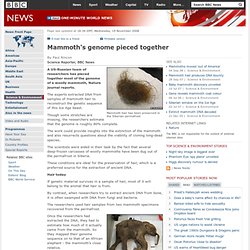

Tiny water flea has the biggest genome ever sequenced. Genetic study sheds light on Jewish diaspora. 9 June 2010Last updated at 18:34 Most contemporary Jews descended from ancient residents of the Levant Scientists have shed light on Jewish history with an in-depth genetic study.

The researchers analysed genetic samples from 14 Jewish communities across the world and compared them with those from 69 non-Jewish populations. Their study, published in Nature, revealed that most Jewish populations were "genetically closer" to each other than to their non-Jewish neighbours. It also revealed genetic ties between globally dispersed Jews and non-Jewish populations in the Middle East. This fits with the idea that most contemporary Jews descended from ancient Hebrew and Israelite residents in the Middle Eastern region known as the Levant. Doron Behar from Rambam Health Care Campus in Haifa, Israel, led an international team of scientists in the study.
There were exceptions to this key finding, though, as Dr Behar explained. Ten extinct beasts that could walk the Earth again. THE recipe for making any creature is written in its DNA.

So last November, when geneticists published the near-complete DNA sequence of the long-extinct woolly mammoth, there was much speculation about whether we could bring this behemoth back to life. Creating a living, breathing creature from a genome sequence that exists only in a computer's memory is not possible right now. But someone someday is sure to try it, predicts Stephan Schuster, a molecular biologist at Pennsylvania State University, University Park, and a driving force behind the mammoth genome project. So besides the mammoth, what other extinct beasts might we coax back to life? Well, it is only going to be possible with creatures for which we can retrieve a complete genome sequence. Mammoth Genome Decoded. November 19, 2008 Using hairs from woolly mammoths, scientists have sequenced an extensive genome of these elephant cousins, a new report says.

The development brings researchers a step closer to "resurrecting" the extinct species via cloning, though so many technical obstacles stand in the way that some experts doubt it could ever happen. (See "Mammoths to Return? DNA Advances Spur Resurrection Debate" [June 25, 2007].) The study is said to be the first ever decoding of an extinct species' nuclear DNA, which contains vast amounts information. Mammoth's genome pieced together. A US-Russian team of researchers has pieced together most of the genome of a woolly mammoth, Nature journal reports.

The experts extracted DNA from samples of mammoth hair to reconstruct the genetic sequence of this Ice Age beast. Though some stretches are missing, the researchers estimate that the genome is roughly 80% complete. The work could provide insights into the extinction of the mammoth and also resurrects questions about the viability of cloning long-dead species.
The scientists were aided in their task by the fact that several deep-frozen carcasses of woolly mammoths have been dug out of the permafrost in Siberia. These conditions are ideal for the preservation of hair, which is a preferred source for the extraction of ancient DNA. Hair today If genetic material survives in a sample of hair, most of it will belong to the animal that hair is from. By contrast, when researchers try to extract ancient DNA from bone, it is often swamped with DNA from fungi and bacteria. Back for good? Zoologger: The most kick-ass fish in the sea - life - 05 May 2010 - New ... Zoologger is our weekly column highlighting extraordinary animals – and occasionally other organisms – from around the world.

Species: Takifugu rubripes Habitat: Deep in the seas around Japan, and the north-west Pacific; fish tanks in sushi restaurants, looking nervous If you were looking for an animal to take the title of "most kick-ass fish in the sea", then the tiger puffer would have to be a strong contender. Not only is it lethally poisonous – though that doesn't stop people trying to eat it – and able to scare off predators by inflating itself to become much larger than normal, when it is young it munches on its own brothers and sisters. Tiger puffers attach their eggs to rocks near the bottom of the sea, often at the mouths of bays. It's no innocent childhood for the pufferfish, though, as Shin Oikawa of Kyushu University in Fukuoka, Japan, and colleagues found when they hatched tiger puffer larvae in the lab and monitored them for two months. Play nicely Come and have a go.